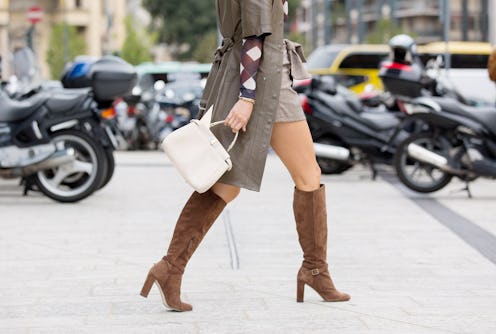(Fashion)
The 4 Must-Follow Rules Of Buying Fall Boots

If you’ve been itching to ditch your pedicure-friendly sandals, the time is finally here. It's officially boot season, and while every woman has her own idea of what constitutes the perfect design, one aspect carries weight for almost everyone. The ideal boot needs to be sturdy enough to get you through your commute. But alas, a comfortable pair of fall boots isn't always as easy to find as one might think. Rubbing, blisters, and pinched toes are all risks when you're opting for a new pair.
“Boots are different than [other] shoes in one major respect ... how high they go,” says Suzanne Levine, a Podiatrist and founder of Institute Beauté. “Because the boot extends over multiple joints, it has to be able to accommodate motion at all of these joints. Proper fit is even more important for boots than [other] shoes.”
Tania Spinelli, chief design officer at Tamara Mellon, echoes Levine’s emphasis, but adds a few more pain points to watch out for. "I look for a walkable heel height, sensible pitch, and good quality leather that will stretch and mold to your foot,” Spinelli explains. “The number one priority for me is heel height.”
While sartorially, your ideal boot choice is dependent on personal style, before you spring for a new pair, you'll want to take note of the four comfort contingencies below. Take it from the experts: Comfort and style can coexist if you know what to look out for. Armed with their advice, you'll save on a seasons-worth of emergency Uber rides home.
Wiggle Room
It may seem like common sense to look for boots that don't suffocate your feet, but finding a pair with just the right amount of roominess can make all the difference. “If you have trouble putting the boot on, it is probably too tight and you probably will never wear it," Levine says, adding that too-tight boots not only restrict motion, but can lead to painful blisters.
To make sure the fit is just right, use the finger-press test. “When standing, there should be about one finger width in front of your longest toe when someone presses down,” Levine explains.
She also suggests road testing the boots for at least five minutes before investing in them. Watch out for any pinching or binding: "The entire foot should feel slightly snug in the boot, except for your heel.”
Heel Height
Besides pinching, you'll want to take note of a boot's heel height, especially if you plan to do a lot of walking. According to Spinelli, a 3.54-inch heel is just the right amount of loft. She notes it as “the ideal heel height to take you from day to night," if you're looking for something with a substantial rise, but don't want to feel limited.
In addition to heel height, it's also worth noting the width and shape of a heel. A chunkier iteration will be easier to navigate in than one with a spindly, stiletto heel. “We create well balanced lasts, [the mold used to make a shoe], to ensure even weight distribution between the heel and the ball of the foot,” Spinelli says.
Quality, Quality, Quality
While every fashion girl loves a great leather boot, paying attention to the quality and composition of the material can make the difference between a 5,000-step boot and one that causes blisters within the first hour. “I love [Tamara Mellon's] Icon 75mm. It’s the perfect slouch boot, made from super soft nappa leather, and with a great mid-heel height,” Spinelli explains
Besides the look and feel, luxe leather can actually give you a leg up when trying to fit into a snug boot. “If your boots are too tight, there is a glimmer of hope if they are made of leather,” Levin explains. “A shoemaker may be able to stretch them a little. It’s worth a try, but don’t force it."
Inside Out
In the same way you never judge a book by its cover, never choose a boot based solely on its exterior. “Winter boots, if they are lined, might be too tight,” Levine says. “Not only is tightness restrictive of motion, it can also encourage heat build-up, sweating, malodor, and blisters.”
With that said, look for a boot with a thin lining and cushioned inside, or consider sizing up if necessary. Spinelli also recommends looking for boots with a memory foam insole for extra comfort. When trying on your boots, consider bringing a pair of thicker socks along to make sure your feet won't be squished.
This article was originally published on